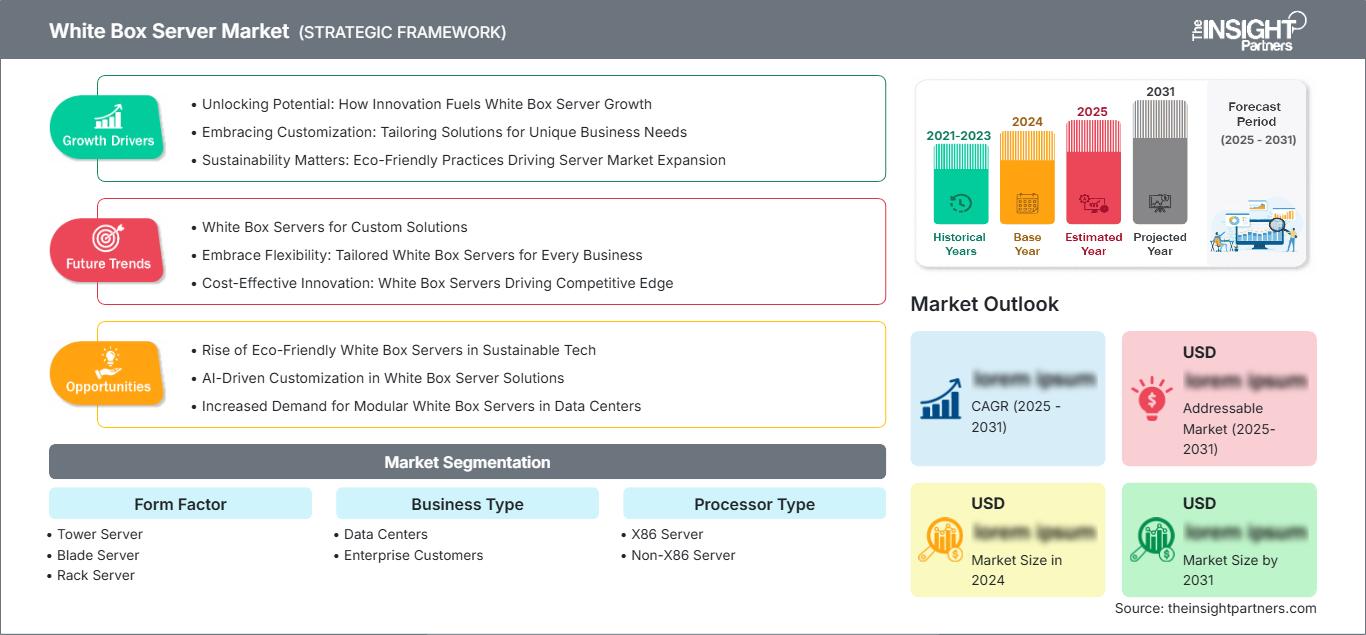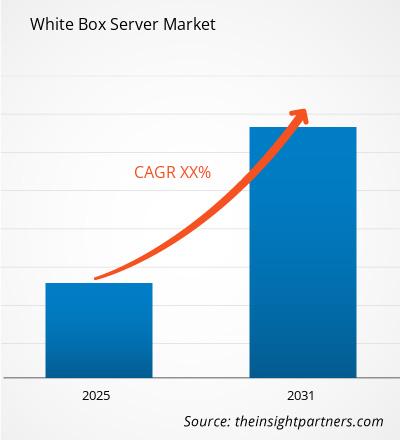Le marché des serveurs White Box devrait enregistrer un TCAC de XX % entre 2025 et 2031, avec une taille de marché passant de XX millions de dollars américains en 2024 à XX millions de dollars américains d'ici 2031.
Le rapport est classé par facteur de forme (serveur tour, serveur lame, serveur rack, serveur à densité optimisée) et analyse plus en détail le marché en fonction du type d'entreprise (centres de données, entreprises). Il examine également le marché par type de processeur (serveur X86, serveur non X86) et par système d'exploitation industriel (Linux, Windows). Une ventilation complète est fournie aux niveaux mondial, régional et national pour chacun de ces segments clés. Le rapport inclut la taille du marché et les prévisions pour tous les segments, présentées en USD. Français Il fournit également des statistiques clés sur l'état actuel du marché des principaux acteurs, ainsi que des informations sur les tendances actuelles du marché et les opportunités émergentes.
Objectif du rapport
Le rapport White Box Server Market de The Insight Partners vise à décrire le paysage actuel et la croissance future, les principaux facteurs moteurs, les défis et les opportunités. Cela fournira des informations à diverses parties prenantes commerciales, telles que :
- Fournisseurs de technologies/Fabricants : Pour comprendre l'évolution de la dynamique du marché et connaître les opportunités de croissance potentielles, leur permettant de prendre des décisions stratégiques éclairées.
- Investisseurs : Pour mener une analyse complète des tendances concernant le taux de croissance du marché, les projections financières du marché et les opportunités qui existent tout au long de la chaîne de valeur.
- Organismes de réglementation : Pour réglementer les politiques et surveiller les activités du marché dans le but de minimiser les abus, de préserver la confiance des investisseurs et de maintenir l'intégrité et la stabilité du marché.
Segmentation du marché des serveurs White Box Facteur de forme
- Serveur tour
- Serveur lame
- Serveur rack
- Serveur à densité optimisée
Type d'entreprise
- Centres de données
- Clients d'entreprise
Type de processeur
- Serveur X86
- Serveur non X86
Système d'exploitation
- Linux
- Windows
Vous bénéficierez d’une personnalisation sur n’importe quel rapport - gratuitement - y compris des parties de ce rapport, ou une analyse au niveau du pays, un pack de données Excel, ainsi que de profiter d’offres exceptionnelles et de réductions pour les start-ups et les universités
Marché des serveurs White Box: Perspectives stratégiques

-
Obtenez les principales tendances clés du marché de ce rapport.Cet échantillon GRATUIT comprendra une analyse de données, allant des tendances du marché aux estimations et prévisions.
Moteurs de croissance du marché des serveurs White Box
- Libérer le potentiel : comment l’innovation alimente la croissance des serveurs White Box
- Adopter la personnalisation : des solutions sur mesure pour les besoins uniques des entreprises
- La durabilité est importante : les pratiques écologiques stimulent l’expansion du marché des serveurs
Tendances futures du marché des serveurs White Box
- Serveurs White Box pour solutions personnalisées
- Adopter la flexibilité : des serveurs White Box sur mesure pour chaque entreprise
- Innovation rentable : les serveurs White Box génèrent un avantage concurrentiel
Opportunités du marché des serveurs White Box
- Ascension des serveurs White Box écologiques dans les technologies durables
- Personnalisation pilotée par l’IA dans les solutions de serveurs White Box
- Demande accrue de serveurs White Box modulaires dans les données Centres
Aperçu régional du marché des serveurs White Box
Les tendances régionales et les facteurs influençant le marché des serveurs White Box tout au long de la période de prévision ont été analysés en détail par les analystes de The Insight Partners. Cette section aborde également les segments et la géographie du marché des serveurs White Box en Amérique du Nord, en Europe, en Asie-Pacifique, au Moyen-Orient et en Afrique, ainsi qu'en Amérique du Sud et en Amérique centrale.
Portée du rapport sur le marché des serveurs White Box
| Attribut de rapport | Détails |
|---|---|
| Taille du marché en 2024 | US$ XX million |
| Taille du marché par 2031 | US$ XX Million |
| TCAC mondial (2025 - 2031) | XX% |
| Données historiques | 2021-2023 |
| Période de prévision | 2025-2031 |
| Segments couverts |
By Facteur de forme
|
| Régions et pays couverts |
Amérique du Nord
|
| Leaders du marché et profils d'entreprises clés |
|
Densité des acteurs du marché des serveurs White Box : comprendre son impact sur la dynamique des entreprises
Le marché des serveurs White Box connaît une croissance rapide, portée par une demande croissante des utilisateurs finaux, due à des facteurs tels que l'évolution des préférences des consommateurs, les avancées technologiques et une meilleure connaissance des avantages du produit. Face à cette demande croissante, les entreprises élargissent leur offre, innovent pour répondre aux besoins des consommateurs et capitalisent sur les nouvelles tendances, ce qui alimente la croissance du marché.

- Obtenez le Marché des serveurs White Box Aperçu des principaux acteurs clés
- Analyse historique (2 ans), année de base, prévision (7 ans) avec TCAC
- Analyse PEST et SWOT
- Taille du marché Valeur / Volume - Mondial, Régional, Pays
- Industrie et paysage concurrentiel
- Ensemble de données Excel
Rapports récents
Témoignages
Raison d'acheter
- Prise de décision éclairée
- Compréhension de la dynamique du marché
- Analyse concurrentielle
- Connaissances clients
- Prévisions de marché
- Atténuation des risques
- Planification stratégique
- Justification des investissements
- Identification des marchés émergents
- Amélioration des stratégies marketing
- Amélioration de l'efficacité opérationnelle
- Alignement sur les tendances réglementaires






















 Obtenez un échantillon gratuit pour - Marché des serveurs White Box
Obtenez un échantillon gratuit pour - Marché des serveurs White Box